Life Processes Class 10 Biology Transportation Notes
What is transportation? What is its importance?
It is the carrying of materials from one part to another of the body. Materials are carried from the region of their availability to the region of their consumption, storage or elimination.
Transportation Importance
- Food. Every cell of the body requires food. It is passed on from the area of synthesis (in plants) or availability (alimentary canal in animals) to all parts of the body through the transport system.
- Oxygen. In animals, oxygen becomes available from the respiratory surface. It is passed on to various parts through transportation.
- Carbon Dioxide. It is produced during respiration. It is carried to the respiratory surface by a transport system for elimination.
- Waste Materials. Metabolic wastes like urea, uric acid and others are first taken to the kidneys for separation and then stored temporarily for elimination through transportation.
- Water. It circulates in the body through a transportation system.
- Hormones. They are poured into the transport system for passage to the area of use.
- Minerals. They are passed from the region of availability to all the parts for utilisation.
- Other Functions. The transportation system has an accessory function of defence against pathogens and plugging the place of injury.
class 10 transportation notes
Transportation in Human Beings
Human beings have a circulatory system for transportation. It consists of a pumping heart, circulatory fluids blood and lymph and tubes. Depending upon the fluid being circulated, the circulatory system is of two types, blood blood-vascular system and the lymphatic system. The blood-vascular system comprises blood, blood vessels and the heart.
Life Processes Class 10 Biology Transportation Notes Heart Beat
What is Heartbeat? How pulse is different from a heartbeat?
It is a rhythmic contraction (systole) and expansion (diastole) of the heart. The rate is 70-72/ minute for adult human males and about 80/minute for adult females. Heartbeat is listened to by an instrument called a stethoscope.
Heartbeat has a low-pitched sound of a longer duration called lubb and a high-pitched shorter duration sound called dup. Lubb represents the simultaneous closure of auriculo-ventricular valve while dup is due to the simultaneous closure of semilunar valves.
Pulse. It is a rhythmic throb felt by a finger over a superficially placed artery (e.g., radial artery below the base of the thumb). Its value is equal to the heartbeat.
Types of Blood Circulation
What is double circulation? Give one importance.
Fishes possess a single blood circulation— venous blood → heart → Gills → Body → Venous blood. An incomplete circulation occurs in amphibians and lizards where mixed blood passes into the body for supply as well as lungs for oxygenation. A complete double circulation occurs in birds and mammals including human beings.
Double Circulation. It is a passage of the same blood twice through the heart, once in a deoxygenated form on the right side and then on the left side in an oxygenated state. The two components of double circulation are pulmonary circulation and systematic circulation.

class 10 science notes biology
1. Pulmonary Circulation. It is a short distance blood circulation from the heart to the lungs and back. Deoxygenated blood collects in the right auricle, is pumped into the right ventricle and from there to the pulmonary trunk.
The latter forms two pulmonary arteries which go to the lungs. In the lungs, the blood is oxygenated. Oxygenated blood flows to the left auricle by means of two pairs of pulmonary veins.
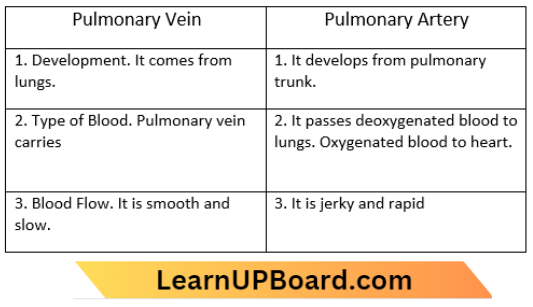
2. Systemic Circulation. It is a long-distance circulation of blood from the heart to all parts of the body except the lungs. The blood circulated by it is oxygenated. This blood becomes deoxygenated in the body tissues.
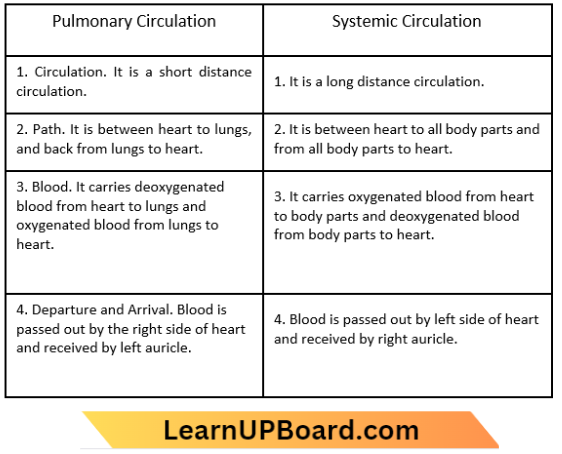
- From there the deoxygenated blood is carried by veins to the right atrium of the heart through a recall, a postcard and a coronary sinus. Nutrients, waste products and other materials are also transported in the process.
- Importance of Double Circulation. Double circulation, as found in birds and mammals, is the most efficient pathway of blood circulation. It provides 100% oxygenated blood to various body parts. The deoxygenated blood is sent by pulmonary circulation to the lungs for complete oxygenation.
- This is helpful for the thermoregulation of the body and the availability of maximum energy for body activities. Animals with incomplete double circulation (amphibians and reptiles) are unable to regulate the temperature of their body.
- Fishes with single circulation use partially oxygenated blood in most parts of their body. They are also unable to regulate their body temperature.
The Tubes: Blood Vessels
Human blood flows only inside closed blood vessels. The latter are of three types-arteries, veins and capillaries.
Arteries. They carry blood coming from the heart to various parts of the body. They are thus distributing blood vessels. Since the blood is coming from the heart, it flows rapidly but with jerks due to alternate expansions.
- The wall is thick and elastic due to the thickening of the middle tunica media. The lumen is narrow. Valves are absent. Most arteries are deep-seated except a few like radial where pulse can be felt. Except for pulmonary arteries, all other arteries cany oxygenated blood. Empty arteries do not collapse.
Veins. They carry blood from various parts of the body towards the heart. They are, therefore, collecting blood vessels. Blood flow is slow but smooth. Internal valves prevent the backflow of blood.
- The wall is moderately thickened as tunica media is a little thickened. The lumen is wide. The empty veins collapse. Most veins are superficial. They carry deoxygenated blood except in pulmonary veins.
- Capillaries. They are narrow (4-10 pm) blood vessels having a single-layered wall which occur in contact with tissues inside all body organs. They are meant for the exchange of materials between blood and body cells.
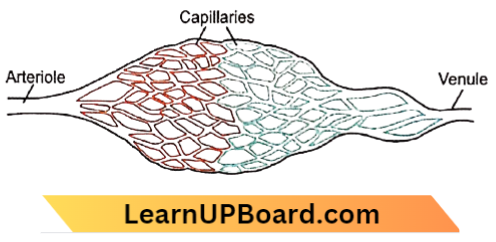
class 10 excretion notes
- For this blood capillaries have fine pores from which some plasma, dissolved substances and even some WBCs come out. It is called a capillary exchange. The reverse flow from cells also occurs.
- The capillary formation is a device to help in the exchange of materials. An artery branches to form arterioles while each arteriole gives rise to several capillaries. The capillaries reunite to produce venules which join to form veins.

Life Processes Class 10 Biology Transportation Notes Blood Pressure
What is blood pressure? Define systolic and diastolic pressure.
The pressure exerted by blood on the wall of an artery is called blood pressure. The instrument used in measuring blood pressure is called a sphygmomanometer. It has a mercury manometer, an inflatable cuff, and a compressible rubber bulb with a screw for pumping and releasing air.
A stethoscope is required. The rubber cuff is wrapped around the upper arm just above the elbow. It is inflated. The diaphragm of the stethoscope is placed over the brachial artery in the fold of the elbow. Air is very slowly released. The first sound of blood flowing in the brachial artery gives systolic pressure.
biology chapter 6 class 10 notes
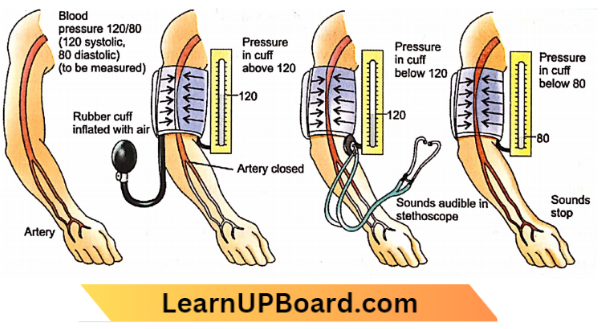
With the further release of air, a point is reached when the sound of flowing blood disappears. It is diastolic pressure. For a normal young person, the two values are 120 mm Hg (systolic) and 80 mm Hg (diastolic).
A higher value, say 140/90 mm Hg is hypertension (high blood pressure) while a lower value, say 110/70 mm Hg, is hypotension (low blood pressure).
Maintenance By Platelets
How do the platelets minimise the leakage of blood from an injured blood tube?
- At the place of injury, the injured blood vessel begins to spill blood. Besides loss of blood, there is a fall of blood pressure which is harmful to the working of the body. Blood platelets (thrombocytes) help in sealing the place of injury.
- On exposure, the platelets release thromboplastin. In the presence of calcium, thromboplastin acts on the prothrombin of blood to form a proteolytic enzyme called thrombin.
- Thrombin acts on blood protein fibrinogen to form insoluble fibrin monomers. Fibrin monomers undergo polymerization. They form long fibres which give rise to a fine network at the place of injury.
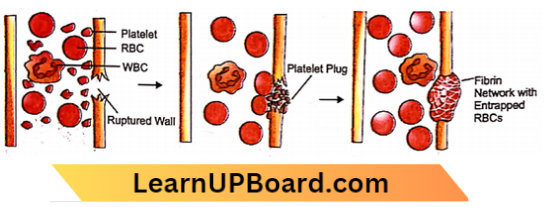
” life processes notes”
- It entraps blood corpuscles. A jelly-like mass called a blood clot is formed. The clot contracts brings the injured walls together and seals the area. A liquid called serum is released during the solidification of the clot.
- It is straw coloured second transport fluid of the body. Lymph is derived from tissue fluid. It is picked up by lymph capillaries which join to form larger lymph vessels. Tissue fluid continues to increase in quantity due to pressure filtering in the blood capillaries.
- Excess of tissue fluid passes out as lymph. Lymph is devoid of red blood corpuscles and blood platelets. It has a small number of leucocytes. Protein content is also less. Lymphocytes (a type of leucocytes) are in good numbers.
- They actually mature in special areas attached to lymph vessels which are called lymph nodes and lymph-containing organs. Lymph-containing organs are adenoids, tonsils, thymus and spleen.
- Lymph capillaries are more permeable than blood capillaries. Therefore, most of the organs pour their secretions into the lymph. In the intestine, lymph vessels called lacteals are involved in the absorption of fat Lymph vessels join to form larger ducts which open into right and left subclavian veins.
- Like veins, movement of lymph in lymph vessels occurs through the milking action of surrounding muscles. Lymph vessels also possess valves, like veins, to prevent backflow of lymph.
Lymph Functions
Blood Volume. Lymph maintains the blood volume of the body which has a tendency to decrease due to plasma filtration in tissues,
- Middleman. Lymph acts as a middleman between tissues/glands and blood,
- Fat. Digested fat is collected by lymph for passing into blood.
- Lymphocytes. They mature in lymph nodes,
- Germs. Lymph capillaries and lymph nodes attract and destroy germs.
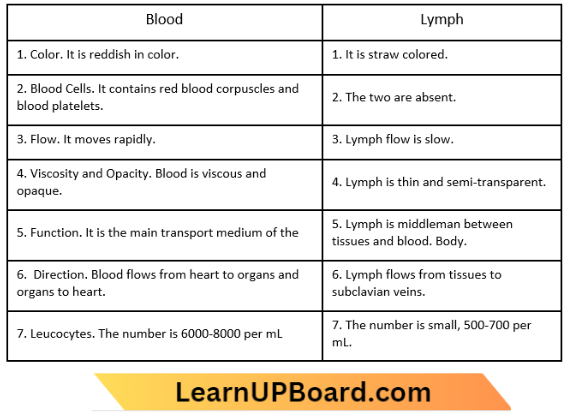
notes for biology class 10
Life Processes Class 10 Biology Transportation Notes Multiple Choice Questions
Which one of the following statements is correct about the human circulatory system?
- Blood transports only oxygen and not carbon dioxide
- The human heart has five chambers
- Valves ensure that the blood does not flow backwards
- Both oxygen-rich and oxygen-deficient blood get mixed up in the heart.
Answer: 3. Valves ensure that the blood does not flow backwards
